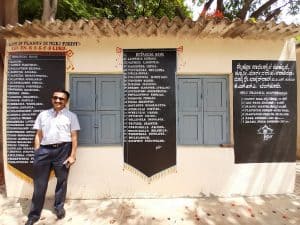Bimal Desai has been a one-man army protecting much of what we see of Cubbon Park. The 14 cases he filed over the last two decades ensured that night-time traffic was banned in the park and encroachments were kept at bay. But one of his learnings while he was fighting the system over the years, was that you can’t always win. So while he continued his legal battles, Desai decided to parallelly start greening the city to compensate for its lost green cover.
Using the Miyawaki method, he has created eight patches of forests in his house, which is set across three acres of land in the heart of Bengaluru.
Using the same method, he has created patches of urban forests inside the Director General of Police premises in MG Road, and is now developing similar spaces near the Cantonment Railway Station and a couple of schools.
“While we continue to fight what the administration plans to do to our common green spaces, there is nothing that stops us from creating lush green forest patches around us. You can start with space as little as 10 ft x 10 ft, where hundreds of trees can be planted,” he says.
But with land being at a premium in a city like Bengaluru, with the increased demand for housing, where does one find this kind of space?

Bimal Desai’s list of trees planted in his mini forest. Pic: Sujnan Herale/Amogh Rayankar
“Builders who have large projects that spread into several acres can use this method to create a lush foliage that runs through the perimeter of their property. The BBMP has many islands built around the most polluted junctions in the heart of the city. This (afforestation) is something we are doing near Cantonment, where the railways have given us land. If each one of us can get this to happen, I can’t see why the city cannot recover its green in five years,” says Desai, as he walks around, showing the forest patches around his house.
His mantra, he says, is simple – stop complaining, start acting. “We are angry about what is being done to our city. But we can reverse it. And it is quite simple. Just needs a little will power,” concludes Desai.
can i reach mr desai? I would like to start with my own 10×10 patch at home
Can we have contact no of mr desai. I need his help for school with 5 acre land wheich is green but inslired by this article i want to convert this to forest
Article would be complete if Reporter updated Bimal Desai email or phone number.
Please share the details of Mr Desai at psadvani@gmail.com.
Sir, you are genious and you are a soldier protesting plants and bringing new ventures to the society. If you need my help let me know we are always there to support you whatever steps you take to control pollution
Hi Sir. I want to know how to adopt this method. Being in real estate, I want to put forth this idea with management. Can I have your contact no. Or please guide me.
Please see http://bengaluru.citizenmatters.in/how-to-make-mini-forest-miyawaki-method-34867
Please share the contact details of Mr Desai.
Dhavalkumar Mashru
GM
Geolife Agritech India Pvt Ltd
8692038944
Good job Mr.Desai, may your tribe increase. You may write an article in citizen matters giving details of how Miyawaki system can be adopted in tropical urban areas. – some links about how to grow mini-Miyawaki forests are given below:
https://www.youtube.com/watch?v=mjUsobGWhs8
https://www.youtube.com/watch?v=-1IVpmYqFfQ
In the name of development, greenery is being destroyed by authorities; they have the habit of announcing bombastic plans for improving afforestation by planting 10 saplings/seedlings for one tree cut by them. It is easy to plant but who has accurate information about how many survived and are growing now? Money is being spent but without visible benefits for invigorating carbon sinks. While we are trying to grow more trees, thousands of trees are being felled for using the wood for curing tobacco leaves in barns. As we know tobacco is not a necessity for our subsistence but and we must stop growing tobacco by helping the farmers to adopt alternate crops so that their produce tobacco can stop felling of trees and killing of people by using the products made out of tobacco.
Staying in an apartment feel no green around me. Live in bldg absolutely no space around the apt. Please give me ideas thoughts how..
for a small balcony space i have and how we can bring green inside home.
Hi,
I am a resident of Chennai and am impressed with the work you do. Can this be implemented here in Chennai too. Will support be provided to start something similar here.
I want start this in my town